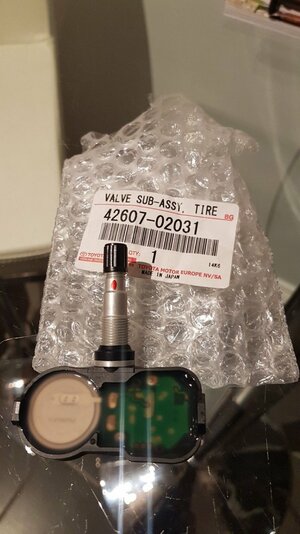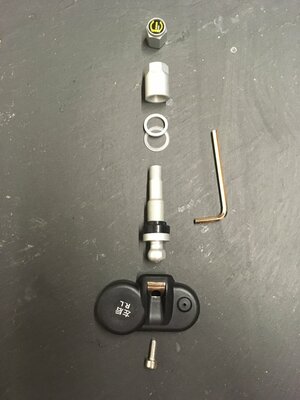I hate getting caught out by punctures or under inflated tyres. It's really annoying when you 'feel something is wrong' and need to stop and find a garage to check the tyres are ok. I also know some cars have a built in TPMS and a dedicated warning light on the dashboard. So I looked for an aftermarket unit to fit to my cat. This unit was the product of much searching and comparing of models and specs. It also comes in two types, both sharing the same Head Unit, but having different sensors :-
It's really annoying when you 'feel something is wrong' and need to stop and find a garage to check the tyres are ok. I also know some cars have a built in TPMS and a dedicated warning light on the dashboard. So I looked for an aftermarket unit to fit to my cat. This unit was the product of much searching and comparing of models and specs. It also comes in two types, both sharing the same Head Unit, but having different sensors :-
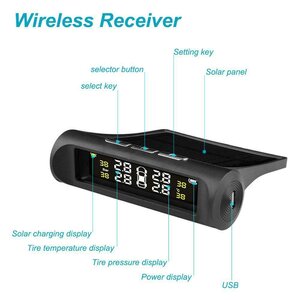
The two sensor options are :-
External, where the dust caps contain the sender units...
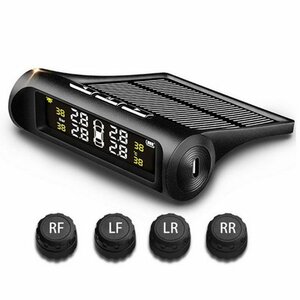
...and Internal, where the sender units are inside the tyres.
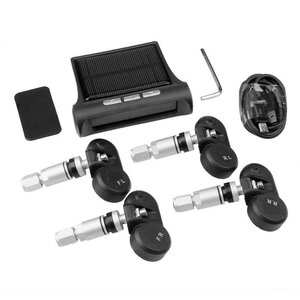
The advantage of External is simplicity to fit, the disadvantage is possible damage, loss or theft. Plus, since they have to be secured by a locknut, they are fiddly when it comes to topping up with air.
Conversely, the Internal sensors are difficult if not impossible to fit yourself and likely to cost a 'valve and balance' per wheel, assuming you can get it done. Even then the fitter needs to know how to fit them properly without damaging them and likewise whenever you have the wheels / tyres worked on.
I suspect the sensor's weight may also require extra balancing weights over a standard valve / dust cap.
Here is the published spec. for the unit with Internal sensors :
Specification:
Sensor communication fault alarm duration: ≤10min
Battery model: CR2450HR (capacity: 550mAh)
RF frequency: 433.92±0.1MHz
No RF emission average operating current: ≤1μA
RF emission maximum operating current: ≤15mA
High frequency transmission power: 7~9dBm at 50Ω
High frequency modulation mode: FSK (9.6Kbps)
Low frequency receiving frequency: 125±5 KHz
Low frequency receiving mode: ASK (3.9Kbps)
Low frequency signal receiving sensitivity: 1~50mVp-p
Pressure measurement range: 0~4.5Bar
Pressure measurement resolution: 25mBar
Temperature measurement resolution: 2 ° C
Pressure measurement accuracy: ±75 mBar at -20°C~+70°C, ±150 mBar at -40°C~+120°C
Temperature measurement accuracy: ±4°C at -20°C~+70°C
Resistance to rotation: ≥1500g
Operating temperature range: -40 ° C ~ +105 ° C
Storage temperature range: -40 ° C ~ +125 ° C
Size: 90*75*25mm/3.54*2.95*0.98"
Weight: 68g
If it is not clear from the above, high and low level alarms can be set for the pressures and temperatures, plus a low sensor battery alarm is provided. Please note that on first use, the menu button must be held until the unit powers on ( or you will think its a dud ). Thereafter it powers on whenever there is movement and the sensors do the same.
I decided that the ideal path was to start with External Sensors and then migrate to Internal ones if the unit proved satisfactory. Coincidentally, two similarly styled units appeared on eBay, with an External one off the shelf in the UK and an Internal one from China, so I bought both. The first turned up next day, and after charging it, I found that the right hand button was faulty. I had to complain and was asked for a picture of it not working !? However, after a bit of frustration I got my money back and to keep the unit - hmmm...
Unbelieveably, after only 6 days, the other unit arrived from China, I was well impressed. However, I still wanted to start with the External sensors, so these would need to work with the Internal head unit straight away. The way they are sold, both Internal and External, would lead you to believe that they are all fixed FL, FR, RL & RR. They are even stamped as such. However, I was convinced these should all be interchangeable and could not believe that the valve / sensor would need to be changed over if the tyres were rotated.
I was right and have now re-paired the External Sensors with the Internal Head Unit and even swapped them around ( front to back and left to right ). I was glad of this or I would have been in deep trouble. I have also identified the fault on the first head unit as being akin to someone using my grandfather's vintage tinsmith's soldering iron to fit an SMD microswitch. I've also located replacements costing £1.21 for 100 from Hong Kong - happy days !
This has all been fitted to the car and the head unit, which is quite small, just happens to fit in the ashtray which I don't use except for business cards ( now removed ). Forgive the odd pressures, this was as I found it and partly why I bought the thing in the first place. I can also say that after a couple of weeks and a 1,000 or so miles, the adjusted pressures have remained steady and consistent. I.e. these caps which are clearly open to the tyre contents the whole time - don't leak. Temperatures on the external units I susepct are nearer ambient whilst driving, I'm hoping the Internal ones will be more realistic. Please note the flash on my phone has made the display look less bright than it really is.
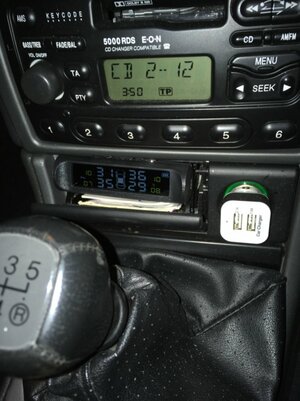
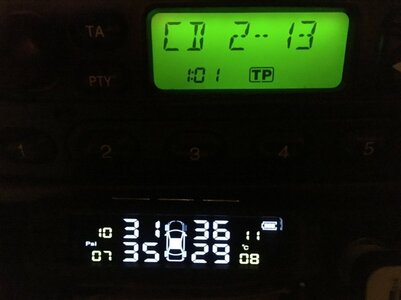
The display is also in various colours not visible in this low light picture ( red, yellow, white ).
Other points to note - I'm not sure I want to rely upon the 'solar cell' on the top, certainly not with mine in the ashtray ! However, the micro USB connector could be easily connected to a cigarette lighter adapter as I have some 6" leads. However, on a bright day, sitting it in the window charging whilst parked might be an option. However, on only the initial charge, the 3 bars battery status display has not changed in 2 weeks / 1,000 miles. Also, the instructions say the alarm can be silenced by pressing 'any button'. I may yet need to find the 'any button' or perhaps I was just inundated with multiple errors whilst setting up. This is unlikely to be a problem in use or I might have a real problem of a different nature if I ignore it.
The Review Conclusion is that this is an inexpensive and useful unit, I am well pleased with it, time will tell.
Purchase price was around £20, but do shop around and make sure you get the right model ( External or Internal ). Rather than give you a link, since the one I used has already expired, I suggest that you search on eBay for 'solar tpms' and just sort on Lowest Price + P&P.
Product Quality, I must put as a 4 out of 5 due to the initial problem with one of them. That is probably a bit unfair on the second unit which was perfect. But generally they are well built and even tidy inside. Some of the protective film on the solar cell and display was a bit annoying and had to be removed carefully. ( I dived in and took the lid off for this ).
Value for Money I consider High at 5 out of 5. Especially with the Internal Sensors which are well engineered. This will hopefully save me a fortune on damaged tyres due to running under inflated, spotting a slow puncture quickly and before I hit the motorway ( I do not like changing a wheel on a slip road as I have done in gales and rain ). I suspect that on my cat a combination of wide tyres and power steering can sometimes cause loss of pressure when manoeuvring, cornering. ( Or perhaps its my driving ).
Overall Rating 5 out of 5, forgiving the faulty unit as it was after all refunded and could have been replaced easily.
If anyone decides to buy one of these, I'm happy to share my experiences on reprogramming the sensors. I am intending to fit one Internal Sensor at a time as my wheels receive attention, so will have a 'hybrid' system for a while. Finally my Wife will end up with the other unit if I can fix it.
Have fun - Noel ( Foobar )

The two sensor options are :-
External, where the dust caps contain the sender units...

...and Internal, where the sender units are inside the tyres.

The advantage of External is simplicity to fit, the disadvantage is possible damage, loss or theft. Plus, since they have to be secured by a locknut, they are fiddly when it comes to topping up with air.
Conversely, the Internal sensors are difficult if not impossible to fit yourself and likely to cost a 'valve and balance' per wheel, assuming you can get it done. Even then the fitter needs to know how to fit them properly without damaging them and likewise whenever you have the wheels / tyres worked on.
I suspect the sensor's weight may also require extra balancing weights over a standard valve / dust cap.
Here is the published spec. for the unit with Internal sensors :
Specification:
Sensor communication fault alarm duration: ≤10min
Battery model: CR2450HR (capacity: 550mAh)
RF frequency: 433.92±0.1MHz
No RF emission average operating current: ≤1μA
RF emission maximum operating current: ≤15mA
High frequency transmission power: 7~9dBm at 50Ω
High frequency modulation mode: FSK (9.6Kbps)
Low frequency receiving frequency: 125±5 KHz
Low frequency receiving mode: ASK (3.9Kbps)
Low frequency signal receiving sensitivity: 1~50mVp-p
Pressure measurement range: 0~4.5Bar
Pressure measurement resolution: 25mBar
Temperature measurement resolution: 2 ° C
Pressure measurement accuracy: ±75 mBar at -20°C~+70°C, ±150 mBar at -40°C~+120°C
Temperature measurement accuracy: ±4°C at -20°C~+70°C
Resistance to rotation: ≥1500g
Operating temperature range: -40 ° C ~ +105 ° C
Storage temperature range: -40 ° C ~ +125 ° C
Size: 90*75*25mm/3.54*2.95*0.98"
Weight: 68g
If it is not clear from the above, high and low level alarms can be set for the pressures and temperatures, plus a low sensor battery alarm is provided. Please note that on first use, the menu button must be held until the unit powers on ( or you will think its a dud ). Thereafter it powers on whenever there is movement and the sensors do the same.
I decided that the ideal path was to start with External Sensors and then migrate to Internal ones if the unit proved satisfactory. Coincidentally, two similarly styled units appeared on eBay, with an External one off the shelf in the UK and an Internal one from China, so I bought both. The first turned up next day, and after charging it, I found that the right hand button was faulty. I had to complain and was asked for a picture of it not working !? However, after a bit of frustration I got my money back and to keep the unit - hmmm...
Unbelieveably, after only 6 days, the other unit arrived from China, I was well impressed. However, I still wanted to start with the External sensors, so these would need to work with the Internal head unit straight away. The way they are sold, both Internal and External, would lead you to believe that they are all fixed FL, FR, RL & RR. They are even stamped as such. However, I was convinced these should all be interchangeable and could not believe that the valve / sensor would need to be changed over if the tyres were rotated.
I was right and have now re-paired the External Sensors with the Internal Head Unit and even swapped them around ( front to back and left to right ). I was glad of this or I would have been in deep trouble. I have also identified the fault on the first head unit as being akin to someone using my grandfather's vintage tinsmith's soldering iron to fit an SMD microswitch. I've also located replacements costing £1.21 for 100 from Hong Kong - happy days !
This has all been fitted to the car and the head unit, which is quite small, just happens to fit in the ashtray which I don't use except for business cards ( now removed ). Forgive the odd pressures, this was as I found it and partly why I bought the thing in the first place. I can also say that after a couple of weeks and a 1,000 or so miles, the adjusted pressures have remained steady and consistent. I.e. these caps which are clearly open to the tyre contents the whole time - don't leak. Temperatures on the external units I susepct are nearer ambient whilst driving, I'm hoping the Internal ones will be more realistic. Please note the flash on my phone has made the display look less bright than it really is.


The display is also in various colours not visible in this low light picture ( red, yellow, white ).
Other points to note - I'm not sure I want to rely upon the 'solar cell' on the top, certainly not with mine in the ashtray ! However, the micro USB connector could be easily connected to a cigarette lighter adapter as I have some 6" leads. However, on a bright day, sitting it in the window charging whilst parked might be an option. However, on only the initial charge, the 3 bars battery status display has not changed in 2 weeks / 1,000 miles. Also, the instructions say the alarm can be silenced by pressing 'any button'. I may yet need to find the 'any button' or perhaps I was just inundated with multiple errors whilst setting up. This is unlikely to be a problem in use or I might have a real problem of a different nature if I ignore it.
The Review Conclusion is that this is an inexpensive and useful unit, I am well pleased with it, time will tell.
Purchase price was around £20, but do shop around and make sure you get the right model ( External or Internal ). Rather than give you a link, since the one I used has already expired, I suggest that you search on eBay for 'solar tpms' and just sort on Lowest Price + P&P.
Product Quality, I must put as a 4 out of 5 due to the initial problem with one of them. That is probably a bit unfair on the second unit which was perfect. But generally they are well built and even tidy inside. Some of the protective film on the solar cell and display was a bit annoying and had to be removed carefully. ( I dived in and took the lid off for this ).
Value for Money I consider High at 5 out of 5. Especially with the Internal Sensors which are well engineered. This will hopefully save me a fortune on damaged tyres due to running under inflated, spotting a slow puncture quickly and before I hit the motorway ( I do not like changing a wheel on a slip road as I have done in gales and rain ). I suspect that on my cat a combination of wide tyres and power steering can sometimes cause loss of pressure when manoeuvring, cornering. ( Or perhaps its my driving ).
Overall Rating 5 out of 5, forgiving the faulty unit as it was after all refunded and could have been replaced easily.
If anyone decides to buy one of these, I'm happy to share my experiences on reprogramming the sensors. I am intending to fit one Internal Sensor at a time as my wheels receive attention, so will have a 'hybrid' system for a while. Finally my Wife will end up with the other unit if I can fix it.
Have fun - Noel ( Foobar )
Last edited:
